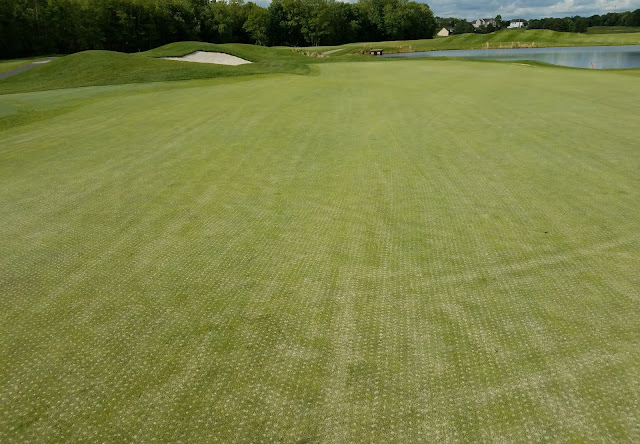Each of these two methods of aerification has its own strengths. While just one of the two may work well for some greens, with Laurel Creek's greens now closing in on 28 years old, we find that the two different methods complement each other, without increasing the recovery time we would see from just core aerifying.
In the case of the hollow tines, we use a very tight hole spacing to remove a significant amount of organic matter from the top few inches of the root zone. These plugs are scooped up using a core harvester and removed. We then apply an average of three tons of sand per green, and broom this in to fill the holes.
The next day the Dryject contractor arrives with four of his amazing machines. This unique piece of equipment creates a very small hole on the surface, while injecting a significant amount of sand into the soil profile, at a deeper level than we can achieve with our conventional aerifier. While this process isn't removing organic matter, it is diluting it, and providing great drainage channels into the heart of the green's root zone.
Grass growers may get a bit giddy seeing the results of the Dryject treatment, shown in the plug below. This is exactly what the greens need to get through the upcoming summer heat.
Immediately after aerifying on Monday and Tuesday, we began using our new roller on Wednesday to smooth the greens. At 1,500+ pounds, this is a pretty heavy piece of equipment, and the results could be seen and felt immediately.
Between the hollow tine and Dryject, we used over 170,000 pounds of sand. Admittedly, there are times when it may appear that we were a bit heavy-handed with the sand, as you can see in the picture of #9 green below.
However, it is generally better to have too much sand than too little after this operation. Check out the picture taken just two days later--we are actually starting to see some green in the green.

Without question, when it comes to aerification, we stand by the old saying that you've got to break a few eggs to make an omelette. When asked why we have to aerify the greens when they've been so good, the answer is simple: Because we want them to continue to be among the best putting surfaces.






No comments:
Post a Comment